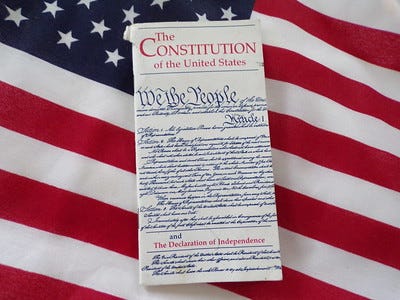Our American Government
Our American Government is a small book published by the House of Representatives for citizens and those who seek a greater understanding of the American interpretation of democracy. It follows a question-and-answer format and covers a broad range of topics dealing with the three branches of our Government, the electoral process, and the role of political parties.
The Savvy Citizen is reproducing the 169 questions-and-answers through a series of posts called Civics 101. Each post will contain the Q&A as well as some additional commentary to add historical context, fun facts, or anything we believe will add to our collective understanding of these topics.
Think of it as your adult Civics class, but without the test!
Let’s keep at it.
SECTION: The Constitution
Q&A #5: What is the Constitution?
The Constitution is the basic and supreme law of the United States. It prescribes the structure of the U.S. Government, provides the legal foundation on which all its actions must rest and enumerates and guarantees the rights due all its citizens.
The Constitution is a document prepared by a convention of delegates from 12 of the 13 States that met a Philadelphia in 1787. The original charter, which replaced the Articles of Confederation and which became operative in 1789, established the United States as a federal union of States, a representative democracy within a republic.
The framers provided a Government of three independent branches.
The first is the legislature, which comprises a two-house or bicameral Congress consisting of a Senate, whose Members are apportioned equally among the States, and a House of Representatives, whose Members are apportioned among the States, according to population.
The second, the executive brand, includes the President and Vide President and all subordinate officials of the executive departments and executive agencies.
The third branch, the judiciary, consists of the Supreme Court and various subordinate Federal courts created by public law.
The 27 amendments approved since 1791 are also an integral part of the Constitution. These include amendments 1 through 10, known collectively as the Bill of Rights, and amendments 11 through 27, which address a wide range of subjects.
At the present time, four amendments without ratification deadlines are pending before the States. These deal with congressional apportionment, child labor, titles of nobility from foreign powers, and certain States rights (in a pre-Civil War proposal).
In addition, the ratification deadlines expired on two proposed amendments, which had been approved by Congress in the 1970s, i.e., equal rights for women and men and voting representation for the District of Columbia in the House and Senate.
My Thoughts …
The most important, but often overlooked, part of the Constitution is the supremacy clause in Article VI which states that the Constitution is the basic and supreme law of the United States. It, and it alone, is the highest law of the land; no one is above it, and no one is below it. This includes the President, Congress, and the Courts.
This also means that the Constitution is superior to the United Nations and every other global organization claiming authority over national responses to global problems. The Constitution governs an independent, sovereign nation-state and surrenders its authority to no one. The United States is one of many independent nations; it is not a part of a new global world order managed and controlled by the United Nations and its partner agencies.
If you remember anything from this series, please remember this!
—
Back tomorrow with Q&A: #6: What were the basic principles on which the Constitution was framed?
Meanwhile, don’t forget that we’re organizing the post links on a single page available here.
xo,
Kelley for the Savvy Citizen Team
October 10, 2024







I know there’s a lot of buzz out there about the UN and WHO trying to impose specific rules and regulations on the USA. I’m glad to read this post, but I keep wondering What If?